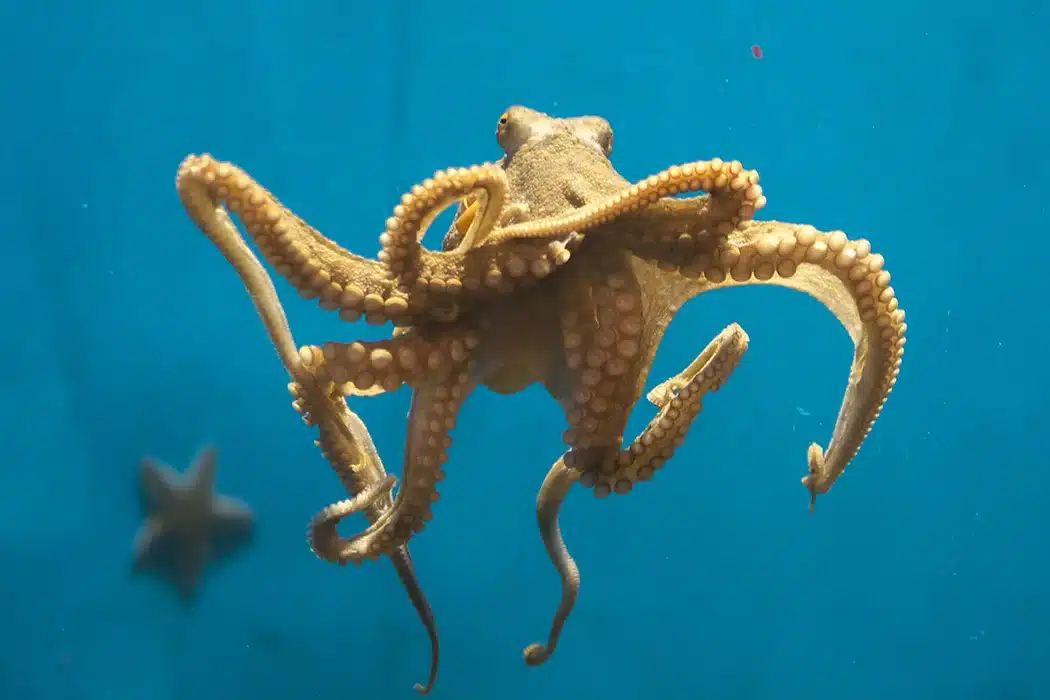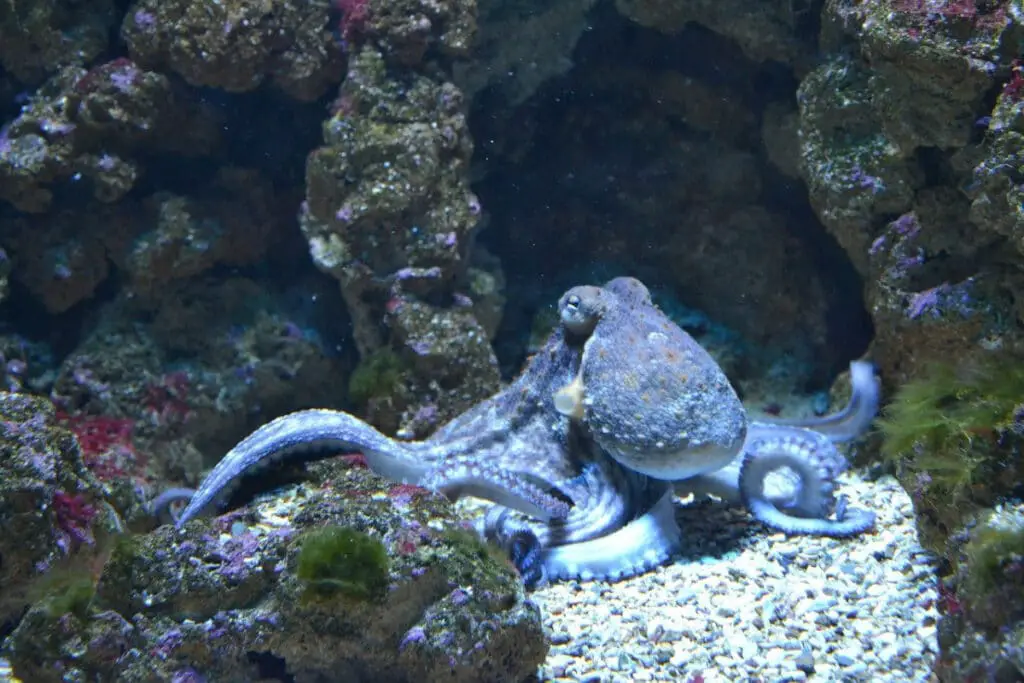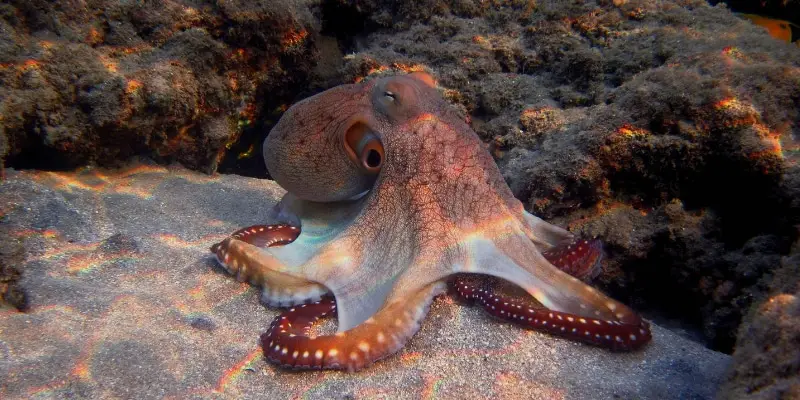Do Octopus Have Arms Or Tentacles

Introduction
Do Octopus Have Arms Or Tentacles: The octopus, a remarkable creature inhabiting the depths of our oceans, has long captured the imagination of scientists, divers, and curious minds alike. Its distinctive appearance, characterized by multiple flexible appendages.
Octopuses are members of the class Cephalopoda, a group that includes squids, cuttlefish, and nautiluses. Their anatomy sets them apart from most other marine life, making them an object of fascination and study. To address the arms vs. tentacles debate, we must delve into the intricacies of octopus anatomy and behavior.
Each octopus possesses eight appendages, which seem similar in function to tentacles. However, the distinction lies in their structure and purpose. Octopus arms are highly dexterous, equipped with suckers along their entire length, and are primarily used for hunting, capturing prey, and manipulating objects. These arms are endowed with an incredible level of flexibility and sensitivity, allowing octopuses to navigate complex underwater environments with precision.
This exploration will provide a comprehensive look into the fascinating world of octopus anatomy, behavior, and the ongoing debate over whether they have arms or tentacles. By shedding light on this intriguing question, we aim to deepen our understanding of these extraordinary marine animals and the secrets hidden within the depths they call home.

What’s the difference between arms and tentacles?
While arms have suction cups the entire length of the limb, suction cups on tentacles are found only near the end of the limb.
The distinction between arms and tentacles primarily lies in their structure and function. Arms, as seen in octopuses, are highly flexible, muscular appendages equipped with suckers along their entire length. They are versatile tools used for tasks such as capturing prey, manipulating objects, and navigating complex underwater environments. Octopus arms are characterized by their extraordinary dexterity and sensitivity, allowing for precise movements and intricate interactions with the surrounding environment.
On the other hand, tentacles, commonly found in creatures like squids, cuttlefish, and jellyfish, are elongated, specialized appendages. Unlike octopus arms, tentacles typically have suckers concentrated only at their tips. These structures are primarily employed for catching and immobilizing prey. Tentacles often exhibit greater length and are less versatile in terms of fine motor control compared to octopus arms.
While the terms “arms” and “tentacles” are often used interchangeably in casual conversation, in the realm of marine biology, they serve to distinguish between the unique anatomical features of different cephalopods and other marine organisms. Understanding these distinctions enhances our appreciation of the remarkable adaptations and strategies that various creatures have evolved to thrive in the underwater world.
Do octopus have arms?
Barring a few exceptions, octopuses have eight arms and no tentacles, while squid and cuttlefish have eight arms (or two “legs” and six “arms”) and two tentacles. The limbs of nautiluses, which number around 90 and lack suckers altogether, are called cirri.
These remarkable marine creatures are renowned for their distinctive anatomy, characterized by eight highly flexible and dexterous appendages known as arms. Octopus arms are lined with numerous suckers along their entire length, allowing for exceptional control, sensitivity, and versatility in their movements.
These arms are not only instrumental in the octopus’s survival but also in its ability to interact with its environment. Octopuses use their arms for a wide range of tasks, including hunting and capturing prey, manipulating objects, and navigating through complex underwater terrain. Their arms can extend, contract, and bend in virtually any direction, giving them unparalleled agility and the capacity to adapt to various situations.
Octopuses exhibit an astonishing level of coordination and intelligence in the way they employ their arms. They can even solve puzzles and open containers with intricate lids using their nimble appendages. This combination of adaptability and brainpower makes octopus arms a fascinating subject of study in the field of marine biology and underscores the extraordinary nature of these enigmatic creatures.
Do octopus have tentacles or tentacles?
Octopuses are gonochoric and have a single, posteriorly-located gonad which is associated with the coelom. The testis in males and the ovary in females bulges into the gonocoel and the gametes are released here.
Octopuses, renowned denizens of the ocean’s depths, possess arms, not tentacles. These distinctions in terminology reflect the unique anatomy and functionality of these marine creatures. Octopus arms are highly flexible, muscular appendages characterized by their remarkable versatility and agility. They are equipped with numerous suction cups along their entire length, allowing octopuses to grasp, manipulate, and explore their surroundings with precision. These arms serve as multi-purpose tools for activities like hunting, capturing prey, and navigating intricate underwater landscapes.
Tentacles, on the other hand, are typically associated with different cephalopods, such as squids and cuttlefish. Tentacles are elongated, specialized structures that often feature suction cups primarily concentrated at their tips. These appendages are primarily used for capturing and immobilizing prey.
The arms-versus-tentacles distinction showcases the diversity of adaptations within the cephalopod family. Octopus arms, with their all-encompassing suction cups and multifunctional nature, are a testament to the incredible versatility and complexity of marine life. Understanding these differences in terminology enhances our appreciation of the intricacies of these remarkable creatures and the roles their appendages play in their survival and interactions with their underwater environments.
Do octopus have 4 arms and 4 legs?
BERLIN (Reuters) – Octopuses’ eight tentacles divide up into six “arms” and two “legs”, a study published by a chain of commercial aquariums said on Thursday. Octopuses are reckoned to be the world’s most intelligent invertebrates and are able to use tools with their sucker-covered tentacles.
Octopuses do not have legs; instead, they have eight arms. This distinction is essential in understanding their unique anatomy and adaptation to underwater life. Octopus arms are highly flexible, muscular structures lined with suction cups that run along their entire length. These arms are incredibly versatile, allowing octopuses to perform a wide range of tasks, including hunting, capturing prey, manipulating objects, and navigating their surroundings.
In contrast, legs are typically associated with animals that move on land, such as mammals like dogs and cats or terrestrial arthropods like insects and spiders. Octopuses, being marine creatures, have adapted their limbs to excel in the aquatic environment, evolving their arms to serve as their primary appendages for locomotion and manipulation.
The absence of legs in octopuses is a testament to their specialization for life in the sea. Their arms provide them with unparalleled agility and control in the water, allowing them to thrive in the complex and dynamic underwater ecosystems they call home. This distinction highlights the incredible diversity of adaptations found in the animal kingdom, each suited to the specific challenges and opportunities presented by their environment.
Can octopus live without an arm?
If an octopus’ arm is cut off without the poor guy being euthanized, it’s no sweat for the cephalopod. While cut-off limbs do not regrow a new octopus, à la starfish, the octopus can regenerate tentacles with a far superior quality than, say, a lizard’s replacement tail, Harmon writes.
Octopuses have a remarkable ability to regenerate lost arms. This regenerative capacity is a fascinating aspect of their biology. If an octopus loses one or more of its arms due to injury or predation, it can often regrow them over time.
Octopus arm regeneration occurs through a complex biological process. Specialized cells called “blastemal cells” are responsible for initiating and coordinating the regrowth. These cells proliferate and differentiate into the various tissues necessary for the development of a new arm, including muscle, skin, and suckers.
The speed of regeneration can vary depending on factors such as the octopus’s age, overall health, and the extent of the injury. In some cases, it may take several weeks or even months for a complete arm to regrow. During this process, the octopus may experience temporary difficulties in hunting and manipulating objects due to the missing arm.
This remarkable regenerative ability showcases the resilience and adaptability of octopuses, allowing them to recover from injuries that might be debilitating or fatal for other animals. It’s a testament to the incredible diversity of life on our planet and the fascinating mechanisms by which different species can cope with challenges and adversity.
What are octopus tentacles made of?
They lack rigid skeletal elements and consist of a three-dimensional array of muscle fibers, relying on a type of skeletal support system called a muscular hydrostat. Support and movement in the arms and tentacles depends on the fact that muscle tissue resists volume change.
Octopus tentacles are marvels of natural engineering, finely tuned for the creature’s aquatic lifestyle. Comprising primarily of muscle, connective tissue, and a unique structure known as a hydrostat, these appendages enable the octopus to perform extraordinary feats of dexterity and strength. The primary component, muscle, consists of specialized fibers that contract and expand, providing the tentacle with both flexibility and power. This muscular arrangement allows the octopus to execute precise movements, from delicate tasks like manipulating objects to rapid, forceful strikes for hunting or self-defense.
The hydrostat is a fascinating feature that sets octopus tentacles apart. It functions akin to a hydraulic system, using water pressure to control movements. By contracting specific muscles, the hydrostat alters the internal pressure, allowing the tentacle to elongate, shorten, or bend in various directions. This hydraulic mechanism grants the octopus an astonishing range of motion and adaptability, making it a formidable predator in the depths.
Connective tissues, such as collagen, provide structural support and help maintain the tentacle’s form. Additionally, these tissues assist in transmitting the forces generated by the muscles, ensuring efficient movement. Together, this intricate combination of muscle, hydrostat, and connective tissue allows the octopus to navigate its environment with unrivaled agility, underscoring the wondrous complexity of nature’s creations.
How do octopuses use their arms for hunting?
Octopuses employ their arms with astonishing precision and versatility when it comes to hunting. Each arm is endowed with a remarkable array of sensory cells, called chemoreceptors, which detect chemical changes in the water. This keen sense allows them to discern the presence of potential prey, even in complete darkness or murky conditions. When an octopus identifies a target, its arms play a multifaceted role in capturing the prey.
Firstly, the octopus swiftly extends its arm towards the intended victim. This extension is facilitated by the hydrostatic skeleton, a system of fluid-filled chambers that enable the arm to elongate and reach out rapidly. Once the arm makes contact with the prey, the suction cups, equipped with powerful muscles, create a vacuum seal, ensuring a firm grip. The cups also have taste receptors, allowing the octopus to confirm that it has captured the desired prey item.
Simultaneously, the remaining arms work in tandem to maintain balance and stability during the hunting process. This coordination is critical to prevent the prey from escaping or the octopus from losing its footing. With its catch secured, the octopus employs its beak to deliver a precise, paralyzing bite. This bite injects a venom that subdues the prey, making it easier for the octopus to consume.
In essence, the octopus utilizes its arms as both a sophisticated sensory tool and a formidable set of appendages for capturing and immobilizing prey, showcasing the extraordinary adaptability and hunting prowess of these enigmatic creatures.
Are there any other animals with tentacles instead of arms?
Yes, several other creatures possess tentacle-like structures rather than traditional arms. One notable example is the squid, a close relative of the octopus. Squid have long, muscular tentacles equipped with powerful suction cups, which they use for a variety of purposes, including capturing prey and maneuvering through the water. These tentacles can be extended and retracted swiftly, allowing squid to launch rapid strikes at their prey.
Another intriguing example is the jellyfish, a marine creature renowned for its delicate, gelatinous appearance. While not technically tentacles, jellyfish possess long, slender appendages called cnidaria that serve similar functions. These specialized structures are lined with stinging cells, called cnidocytes, which the jellyfish employs for capturing prey and defense.
Outside of the aquatic realm, some species of land-dwelling creatures possess appendages that can be likened to tentacles. The elephant trunk, for instance, exhibits a level of dexterity and flexibility reminiscent of tentacles. Comprising thousands of muscles, the trunk enables elephants to perform a wide array of tasks, including grasping objects, siphoning water, and even displaying signs of affection.
While tentacles are most commonly associated with marine invertebrates like octopuses and squid, examples from both the aquatic and terrestrial domains showcase the evolutionary adaptability of appendages in nature. Each of these structures has evolved to suit the specific needs and environments of the creatures that possess them, underscoring the remarkable diversity of life on Earth.

Conclusion
In the quest to determine whether octopuses have arms or tentacles, we’ve delved into the intricate world of these enigmatic sea creatures. Through our exploration, we’ve uncovered the fascinating nuances of octopus anatomy and behavior, shedding light on the arms-versus-tentacles debate.
Octopuses indeed have a unique and complex appendage system that sets them apart from other marine life. Their eight limbs, often referred to as arms, are highly specialized tools designed for various purposes. These arms are equipped with suction cups along their entire length, granting octopuses unparalleled dexterity, sensitivity, and control. They serve as versatile instruments for hunting, capturing prey, and manipulating objects, reflecting their importance in the octopus’s daily life.
On the other hand, the term “tentacles” typically applies to different cephalopods, like squids, which possess two elongated specialized appendages with suckers primarily located at their tips, primarily used for prey capture.
While the arms-versus-tentacles debate may be rooted in terminology, the true marvel lies in the astonishing adaptability and intelligence of octopuses live. Regardless of the terminology used, these incredible creatures continue to captivate scientists and enthusiasts alike, reminding us of the remarkable diversity and mysteries that thrive beneath the surface of our oceans. The debate lives on, but the wonder of the octopus remains unchanged.



